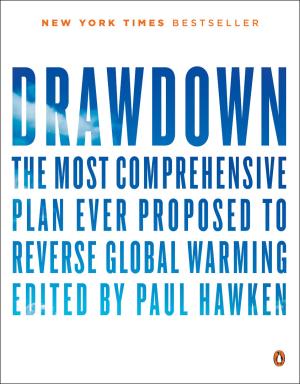True confession: I didn’t read all of Drawdown, Paul Hawken’s new book with the audacious subtitle, “The Most Comprehensive Plan Ever Proposed to Reverse Global Warming.” I dove into many whole sections, but I also skimmed, scanned, and read lots of captions.
Honestly, it’s that kind of book. And no less impactful for that. There is so much to digest here, and the information within these pages works as an appetizer, main course, or dessert.
With it’s clear, clean, and attractive design -- both graphically and editorially -- it conveys an enormous amount of complex, often technical information in an amazingly readable and engaging way. It tells stories. It has characters. It delivers concise histories.
The book is organized into eight categories (Energy, Food, Women and Girls, Buildings and Cities, Land Use, Transport, Materials, and the intriguing, “Coming Attractions”). Within each category, it discusses and ranks different strategies according to each one’s potential to reduce carbon emissions. (All the “greenhouse gases” are converted to carbon equivalents for apples-to-apples comparisons). There are 100 solutions total.
Reading through them, I envisioned stacks of research papers backing up each crisp summary. (There is an extensive list of references in the back.) This may leave a lot of room for experts to nitpick in any given field, but as a layperson, I fully appreciated the synopses. And the relative ranking of impact -- even if there’s likely a considerable large fudge factor, helps you understand where we might focus on first.
I learned so much.
For example, while reading the energy section (by far the most straightforward chapter), a lightbulb went off in my head (a compact fluorescent one!): Because of the vagaries of renewable energy (the sun doesn’t shine all day or every day; wind doesn’t blow consistently; water doesn’t flow evenly year-round), capitalizing on the potential of renewables requires building a more flexible grid and improving energy storage. Given my environmental background, I feel like I should have understood this concept a long time ago, but I never did. Until now.
I paid pretty close attention to ideas that were particularly relevant to the Farm, like the entry on biomass energy. Biomass gets a pretty tepid endorsement as only a “bridge” solution to climate change -- useful only until cleaner energy sources are brought online. Basically, “biomass energy is a viable solution if it uses appropriate feedstock.” When it relies on trees only, the trees may/will grow back eventually, but that’s “a lengthy and uncertain lag time to achieve carbon neutrality.”
Unfortunately, the section on managed grazing was disappointing. But that’s not really the book’s fault. In the area of farming -- grass-based farming in particular -- studies evaluating the collective climate impacts of grazing just aren’t there. Farm practices are so site specific, and their interactions with plants, soils, water, and topography are so complex, that measuring outcomes across farms becomes nearly impossible.
But what is also clear in the grazing section (and echoed throughout the book), is that many of the proposed solutions have multiple benefits in addition to their climate impact.
“Practitioners [of managed grazing] describe significant increases in income due to higher productivity and reduction in expenditures for herbicides, pesticides, fertilizers, diesel fuel, and veterinary costs. And they describe life returning to their land -- flocks of songbirds, native grouse, fox, deer, and pollinating insects such as bees and butterflies.”
Broadly speaking, in fact, this book isn’t just about climate change solutions at all. It’s about sustainable development solutions. And of course, arresting climate change will be the ultimate measure of sustainability
What this book isn’t, despite its subtitle, is a plan. The introduction calls it a “play book,” which is nearer the mark. Also “A road map with a moral compass,” which is also true.
What would make it a real plan? For me, it would be a deeper dive into how to implement these 100 solutions. For the most part, the tools are merely hinted at. Tools like certification systems, taxes, incentive programs, and legislation, which in turn need political courage and -- most stubbornly -- “cultural shifts.”
Ultimately, though, the book is less of a “How to” than a “What if?” It’s aspirational -- and surprisingly hopeful. Without wearing rose-colored glasses, the book has a “We got this,” kind of tone. I liked that. I think we need that.
So grab your own copy and dive in. Start anywhere. Then gather some friends (opponents?), to debate, discuss, and ACT! The time is now.

